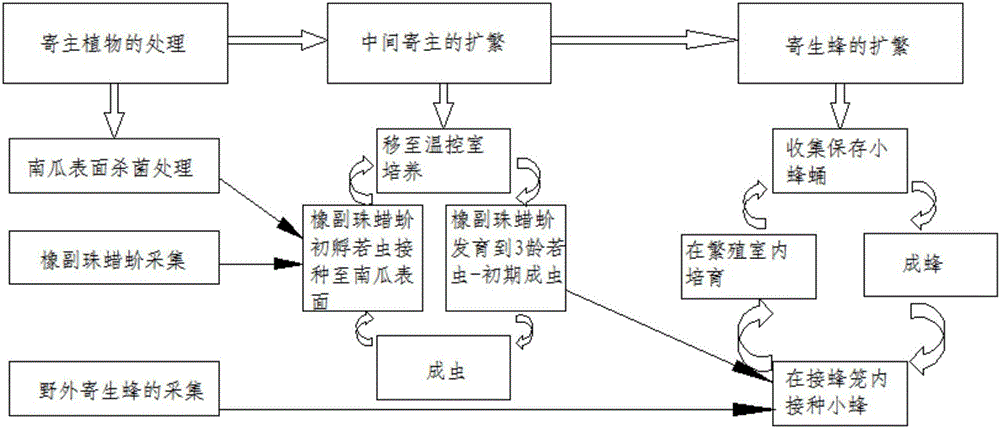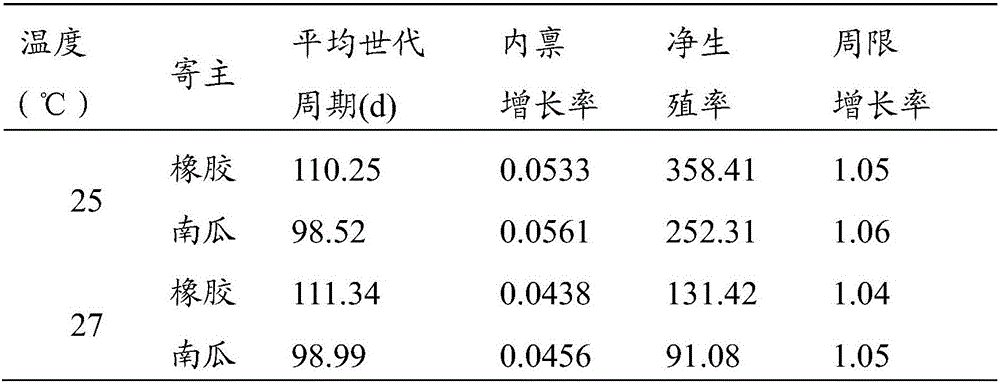Japanese coccophagus expanding propagation method
A technology for Scale-eating wasps and parasitic wasps, which is applied to the propagation field of Japanese Scale-eating wasps, can solve the problems of low parasitic efficiency, high cost, low reproduction efficiency, etc. effect on survival
- Summary
- Abstract
- Description
- Claims
- Application Information
AI Technical Summary
Problems solved by technology
Method used
Image
Examples
Embodiment 1
[0033] Such as figure 1 Shown: A method for propagation of Japanese scale aphid, including the following steps:
[0034] (1) Treatment of host plants
[0035] Choose 3 kg / piece of complete and mature pumpkin as the host plant, clean the surface with a damp cloth, and dry it for later use; mix 70% thiophanate-methyl wettable powder with water to make 1000 times the liquid; use a cloth to soak the liquid on the pumpkin Disinfect the surface, dry it, and let it stand for 2 days.
[0036] (2) Expansion of intermediate hosts
[0037] Choose the waxy bugs of P. oleracea as the intermediate host; collect the rubber branches with the adult nymphs of P. oleracea during the spawning period (and the newly hatched nymphs crawling out from under the adult shell); put them in a light-proof box with only the upper surface opening For propagation, put a few fresh rubber leaves on the rubber branches; collect the newly-incubated nymphs of P. parasitica and gently sweep the surface of the pumpkin wit...
Embodiment 2
[0041] Such as figure 1 Shown: A method for propagation of Japanese scale aphid, including the following steps:
[0042] (1) Treatment of host plants
[0043] Choose every 5 kg / piece of complete and mature pumpkin as the host plant. Clean the surface with a damp cloth and dry it for later use; mix 70% thiophanate-methyl wettable powder with water to make 1000 times the liquid; use a cloth soaked in the liquid to treat the pumpkin Disinfect the surface and leave it to dry for 3 days;
[0044] (2) Expansion of intermediate hosts
[0045] Choose the waxy bugs of P. parasiticum as the intermediate host; collect the rubber branches with the adult nymphs of P. parasiticum during the spawning period (and the newly hatched nymphs crawling out from under the adult scales); put them in a light-proof box with only the upper surface opening For propagation, put a few fresh rubber leaves on top of the rubber branches; collect the newly hatched nymphs of Leucococcus parasiticus and gently sweep t...
Embodiment 3
[0049] Such as figure 1 Shown: A method for propagation of Japanese scale aphid, including the following steps:
[0050] (1) Treatment of host plants
[0051] Choose every 4 kg / piece of complete and mature pumpkin as the host plant. Clean the surface with a damp cloth and dry for later use; mix 70% thiophanate methyl wettable powder with water to make 1000 times the liquid; use a cloth soaked in the liquid to treat the pumpkin Disinfect the surface and let it dry for 2.5 days;
[0052] (2) Expansion of intermediate hosts
[0053] Choose the waxy bugs of P. oleracea as the intermediate host; collect the rubber branches with the adult nymphs of P. oleracea during the spawning period (and the newly hatched nymphs crawling out from under the adult shell); put them in a light-proof box with only the upper surface opening For propagation, put a few fresh rubber leaves on top of the rubber branches; collect the newly hatched nymphs of Leucococcus parasiticus and gently sweep to the surface...
PUM
 Login to View More
Login to View More Abstract
Description
Claims
Application Information
 Login to View More
Login to View More - R&D
- Intellectual Property
- Life Sciences
- Materials
- Tech Scout
- Unparalleled Data Quality
- Higher Quality Content
- 60% Fewer Hallucinations
Browse by: Latest US Patents, China's latest patents, Technical Efficacy Thesaurus, Application Domain, Technology Topic, Popular Technical Reports.
© 2025 PatSnap. All rights reserved.Legal|Privacy policy|Modern Slavery Act Transparency Statement|Sitemap|About US| Contact US: help@patsnap.com



